Health and Safety in the Oil and Gas Industry: A UK Perspective Report
VerifiedAdded on 2020/03/16
|12
|2875
|81
Report
AI Summary
This report provides a comprehensive overview of health and safety challenges within the UK oil and gas industry, focusing specifically on the context of the United Kingdom. It begins with an executive summary highlighting the critical importance of workforce health and safety, emphasizing the need to adhere to legal regulations and industry best practices. The report delves into specific health and safety issues, including explosions and fires, confined spaces, chemical exposures, ergonomic hazards, and high-pressure lines, providing a detailed analysis of the risks associated with each. It then examines the legal requirements, referencing key acts and regulations enforced by the Health and Safety Executive (HSE) and other relevant bodies. Furthermore, the report outlines various strategies for meeting these legal requirements, emphasizing the importance of goal-setting, policy development, and employee training. Finally, it details best practices for mitigating health and safety issues, such as hazard identification, risk control systems, and disaster management teams, offering valuable insights into creating a safer working environment within the oil and gas sector.
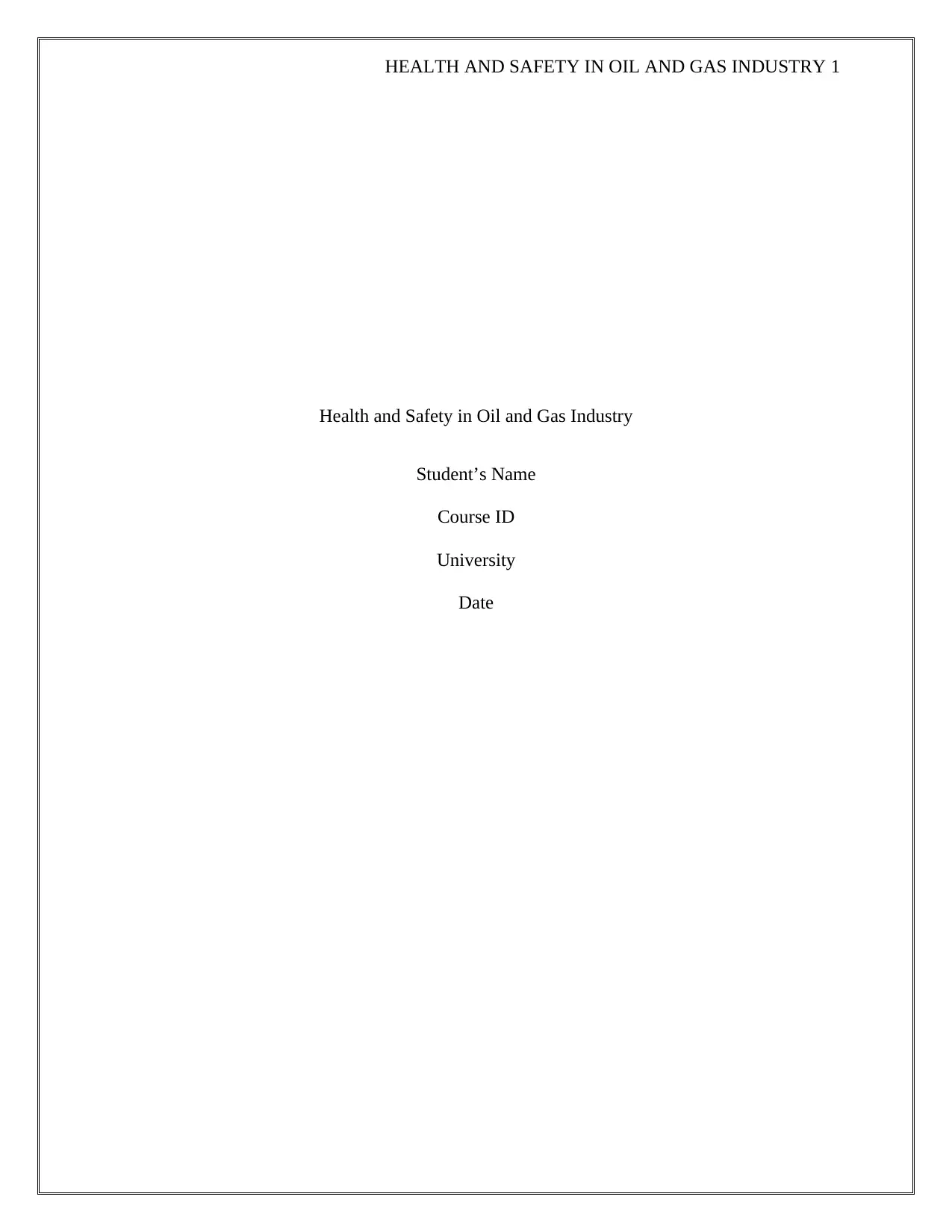
HEALTH AND SAFETY IN OIL AND GAS INDUSTRY 1
Health and Safety in Oil and Gas Industry
Student’s Name
Course ID
University
Date
Health and Safety in Oil and Gas Industry
Student’s Name
Course ID
University
Date
Paraphrase This Document
Need a fresh take? Get an instant paraphrase of this document with our AI Paraphraser
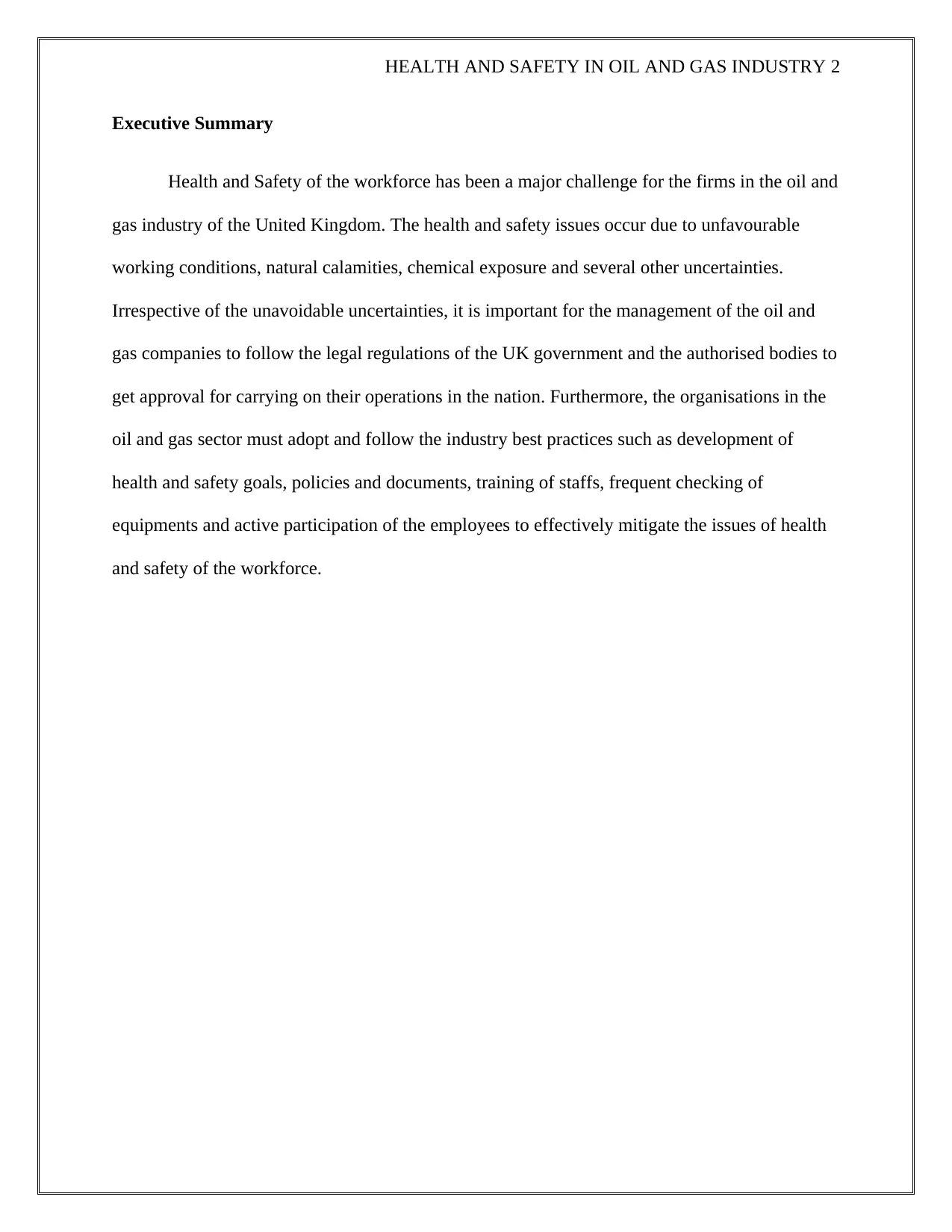
HEALTH AND SAFETY IN OIL AND GAS INDUSTRY 2
Executive Summary
Health and Safety of the workforce has been a major challenge for the firms in the oil and
gas industry of the United Kingdom. The health and safety issues occur due to unfavourable
working conditions, natural calamities, chemical exposure and several other uncertainties.
Irrespective of the unavoidable uncertainties, it is important for the management of the oil and
gas companies to follow the legal regulations of the UK government and the authorised bodies to
get approval for carrying on their operations in the nation. Furthermore, the organisations in the
oil and gas sector must adopt and follow the industry best practices such as development of
health and safety goals, policies and documents, training of staffs, frequent checking of
equipments and active participation of the employees to effectively mitigate the issues of health
and safety of the workforce.
Executive Summary
Health and Safety of the workforce has been a major challenge for the firms in the oil and
gas industry of the United Kingdom. The health and safety issues occur due to unfavourable
working conditions, natural calamities, chemical exposure and several other uncertainties.
Irrespective of the unavoidable uncertainties, it is important for the management of the oil and
gas companies to follow the legal regulations of the UK government and the authorised bodies to
get approval for carrying on their operations in the nation. Furthermore, the organisations in the
oil and gas sector must adopt and follow the industry best practices such as development of
health and safety goals, policies and documents, training of staffs, frequent checking of
equipments and active participation of the employees to effectively mitigate the issues of health
and safety of the workforce.
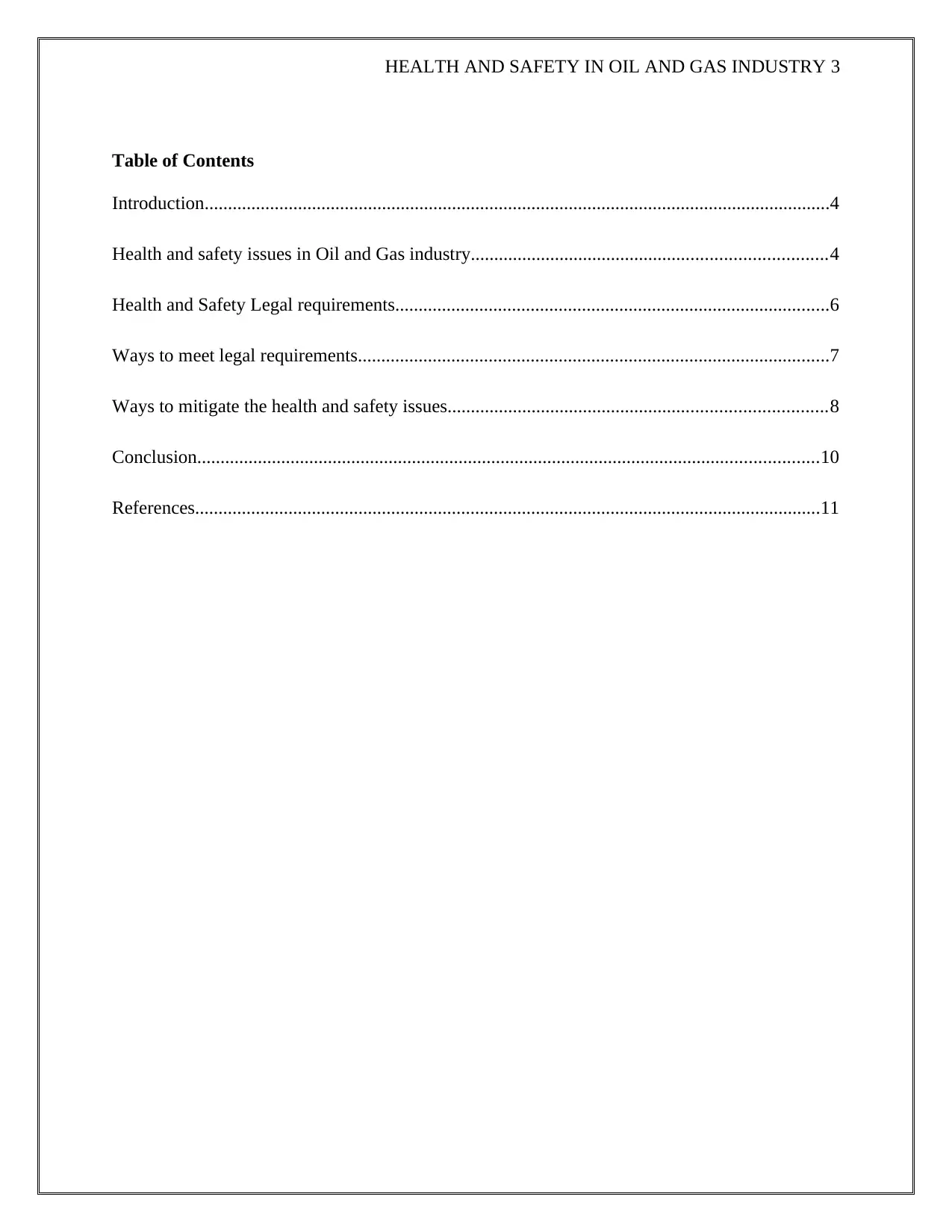
HEALTH AND SAFETY IN OIL AND GAS INDUSTRY 3
Table of Contents
Introduction......................................................................................................................................4
Health and safety issues in Oil and Gas industry............................................................................4
Health and Safety Legal requirements.............................................................................................6
Ways to meet legal requirements.....................................................................................................7
Ways to mitigate the health and safety issues.................................................................................8
Conclusion.....................................................................................................................................10
References......................................................................................................................................11
Table of Contents
Introduction......................................................................................................................................4
Health and safety issues in Oil and Gas industry............................................................................4
Health and Safety Legal requirements.............................................................................................6
Ways to meet legal requirements.....................................................................................................7
Ways to mitigate the health and safety issues.................................................................................8
Conclusion.....................................................................................................................................10
References......................................................................................................................................11
⊘ This is a preview!⊘
Do you want full access?
Subscribe today to unlock all pages.

Trusted by 1+ million students worldwide
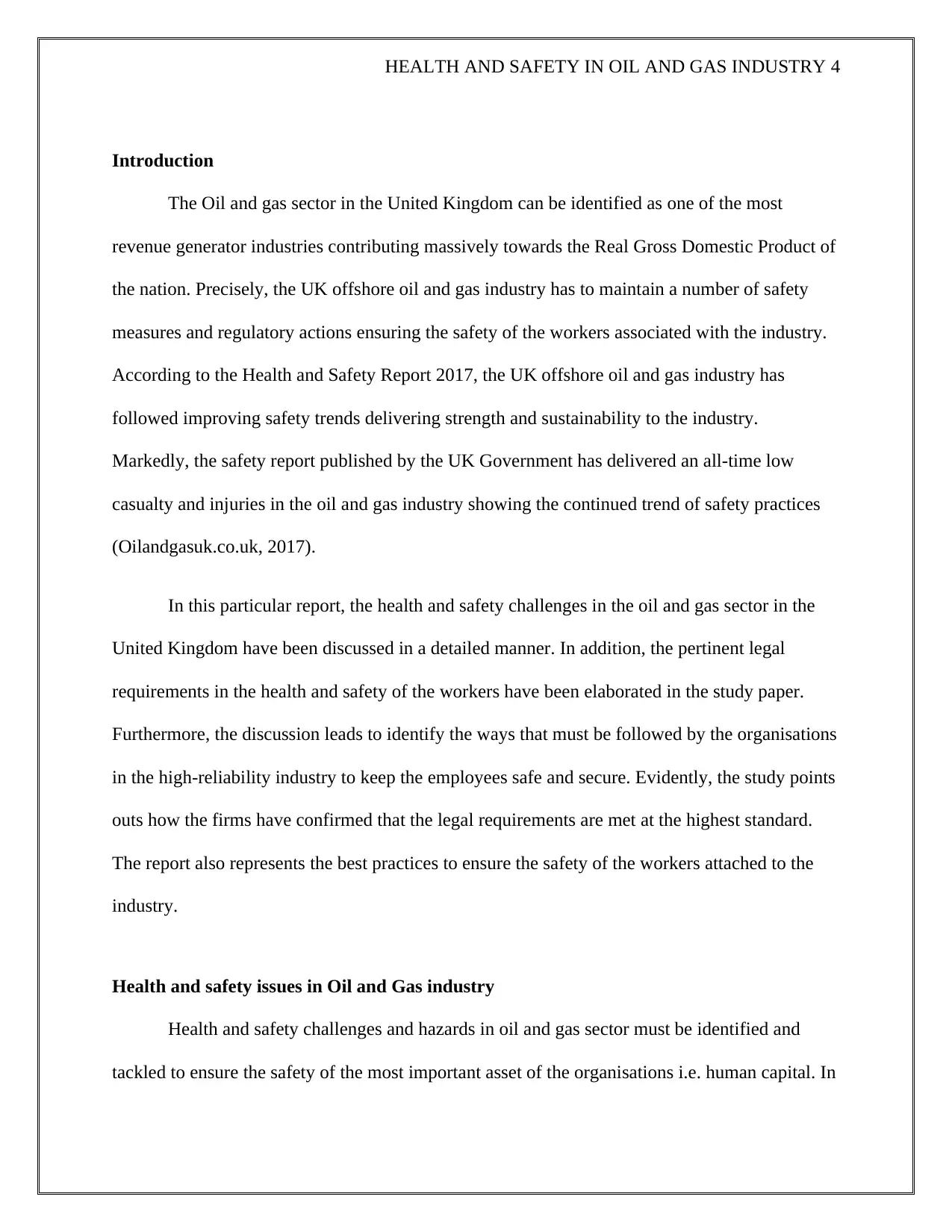
HEALTH AND SAFETY IN OIL AND GAS INDUSTRY 4
Introduction
The Oil and gas sector in the United Kingdom can be identified as one of the most
revenue generator industries contributing massively towards the Real Gross Domestic Product of
the nation. Precisely, the UK offshore oil and gas industry has to maintain a number of safety
measures and regulatory actions ensuring the safety of the workers associated with the industry.
According to the Health and Safety Report 2017, the UK offshore oil and gas industry has
followed improving safety trends delivering strength and sustainability to the industry.
Markedly, the safety report published by the UK Government has delivered an all-time low
casualty and injuries in the oil and gas industry showing the continued trend of safety practices
(Oilandgasuk.co.uk, 2017).
In this particular report, the health and safety challenges in the oil and gas sector in the
United Kingdom have been discussed in a detailed manner. In addition, the pertinent legal
requirements in the health and safety of the workers have been elaborated in the study paper.
Furthermore, the discussion leads to identify the ways that must be followed by the organisations
in the high-reliability industry to keep the employees safe and secure. Evidently, the study points
outs how the firms have confirmed that the legal requirements are met at the highest standard.
The report also represents the best practices to ensure the safety of the workers attached to the
industry.
Health and safety issues in Oil and Gas industry
Health and safety challenges and hazards in oil and gas sector must be identified and
tackled to ensure the safety of the most important asset of the organisations i.e. human capital. In
Introduction
The Oil and gas sector in the United Kingdom can be identified as one of the most
revenue generator industries contributing massively towards the Real Gross Domestic Product of
the nation. Precisely, the UK offshore oil and gas industry has to maintain a number of safety
measures and regulatory actions ensuring the safety of the workers associated with the industry.
According to the Health and Safety Report 2017, the UK offshore oil and gas industry has
followed improving safety trends delivering strength and sustainability to the industry.
Markedly, the safety report published by the UK Government has delivered an all-time low
casualty and injuries in the oil and gas industry showing the continued trend of safety practices
(Oilandgasuk.co.uk, 2017).
In this particular report, the health and safety challenges in the oil and gas sector in the
United Kingdom have been discussed in a detailed manner. In addition, the pertinent legal
requirements in the health and safety of the workers have been elaborated in the study paper.
Furthermore, the discussion leads to identify the ways that must be followed by the organisations
in the high-reliability industry to keep the employees safe and secure. Evidently, the study points
outs how the firms have confirmed that the legal requirements are met at the highest standard.
The report also represents the best practices to ensure the safety of the workers attached to the
industry.
Health and safety issues in Oil and Gas industry
Health and safety challenges and hazards in oil and gas sector must be identified and
tackled to ensure the safety of the most important asset of the organisations i.e. human capital. In
Paraphrase This Document
Need a fresh take? Get an instant paraphrase of this document with our AI Paraphraser
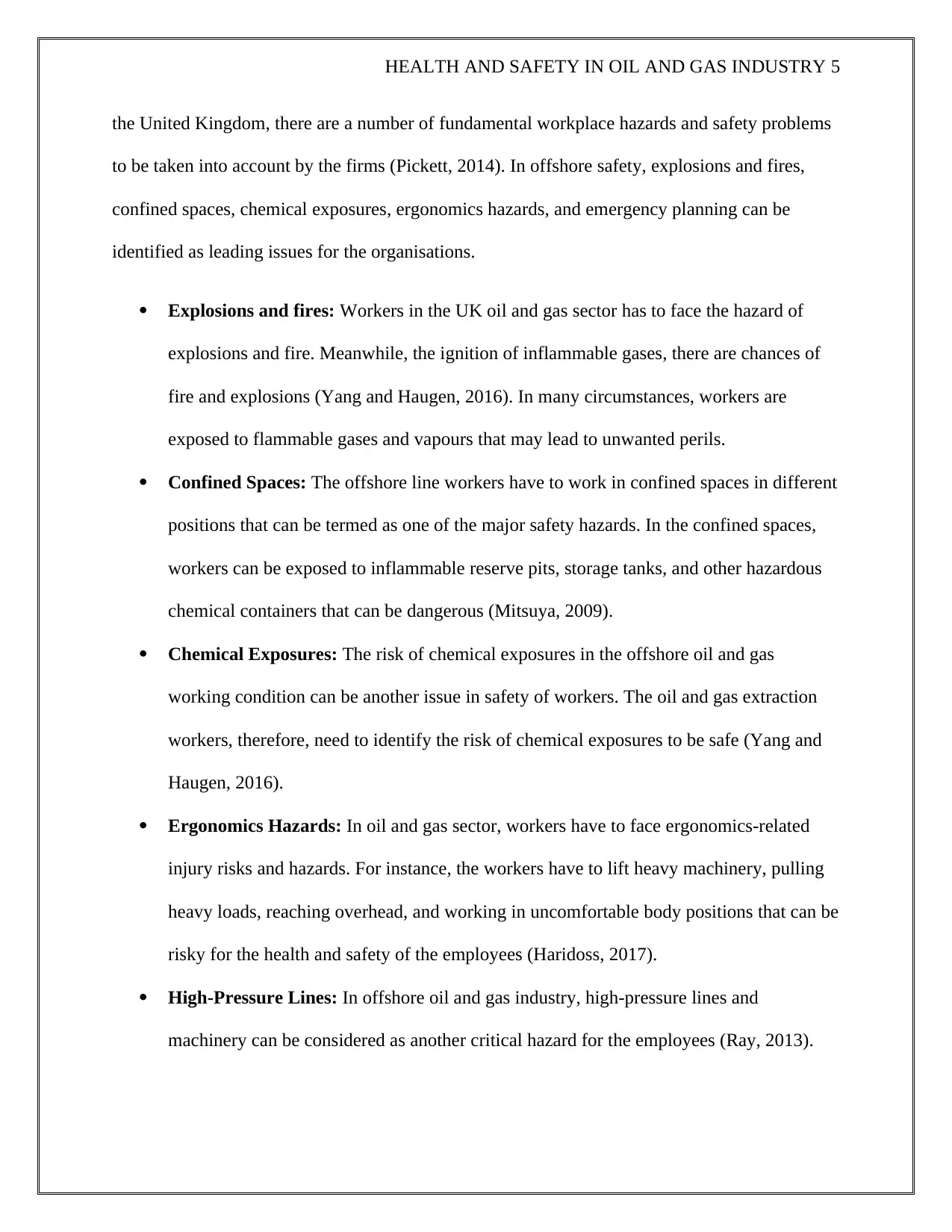
HEALTH AND SAFETY IN OIL AND GAS INDUSTRY 5
the United Kingdom, there are a number of fundamental workplace hazards and safety problems
to be taken into account by the firms (Pickett, 2014). In offshore safety, explosions and fires,
confined spaces, chemical exposures, ergonomics hazards, and emergency planning can be
identified as leading issues for the organisations.
Explosions and fires: Workers in the UK oil and gas sector has to face the hazard of
explosions and fire. Meanwhile, the ignition of inflammable gases, there are chances of
fire and explosions (Yang and Haugen, 2016). In many circumstances, workers are
exposed to flammable gases and vapours that may lead to unwanted perils.
Confined Spaces: The offshore line workers have to work in confined spaces in different
positions that can be termed as one of the major safety hazards. In the confined spaces,
workers can be exposed to inflammable reserve pits, storage tanks, and other hazardous
chemical containers that can be dangerous (Mitsuya, 2009).
Chemical Exposures: The risk of chemical exposures in the offshore oil and gas
working condition can be another issue in safety of workers. The oil and gas extraction
workers, therefore, need to identify the risk of chemical exposures to be safe (Yang and
Haugen, 2016).
Ergonomics Hazards: In oil and gas sector, workers have to face ergonomics-related
injury risks and hazards. For instance, the workers have to lift heavy machinery, pulling
heavy loads, reaching overhead, and working in uncomfortable body positions that can be
risky for the health and safety of the employees (Haridoss, 2017).
High-Pressure Lines: In offshore oil and gas industry, high-pressure lines and
machinery can be considered as another critical hazard for the employees (Ray, 2013).
the United Kingdom, there are a number of fundamental workplace hazards and safety problems
to be taken into account by the firms (Pickett, 2014). In offshore safety, explosions and fires,
confined spaces, chemical exposures, ergonomics hazards, and emergency planning can be
identified as leading issues for the organisations.
Explosions and fires: Workers in the UK oil and gas sector has to face the hazard of
explosions and fire. Meanwhile, the ignition of inflammable gases, there are chances of
fire and explosions (Yang and Haugen, 2016). In many circumstances, workers are
exposed to flammable gases and vapours that may lead to unwanted perils.
Confined Spaces: The offshore line workers have to work in confined spaces in different
positions that can be termed as one of the major safety hazards. In the confined spaces,
workers can be exposed to inflammable reserve pits, storage tanks, and other hazardous
chemical containers that can be dangerous (Mitsuya, 2009).
Chemical Exposures: The risk of chemical exposures in the offshore oil and gas
working condition can be another issue in safety of workers. The oil and gas extraction
workers, therefore, need to identify the risk of chemical exposures to be safe (Yang and
Haugen, 2016).
Ergonomics Hazards: In oil and gas sector, workers have to face ergonomics-related
injury risks and hazards. For instance, the workers have to lift heavy machinery, pulling
heavy loads, reaching overhead, and working in uncomfortable body positions that can be
risky for the health and safety of the employees (Haridoss, 2017).
High-Pressure Lines: In offshore oil and gas industry, high-pressure lines and
machinery can be considered as another critical hazard for the employees (Ray, 2013).
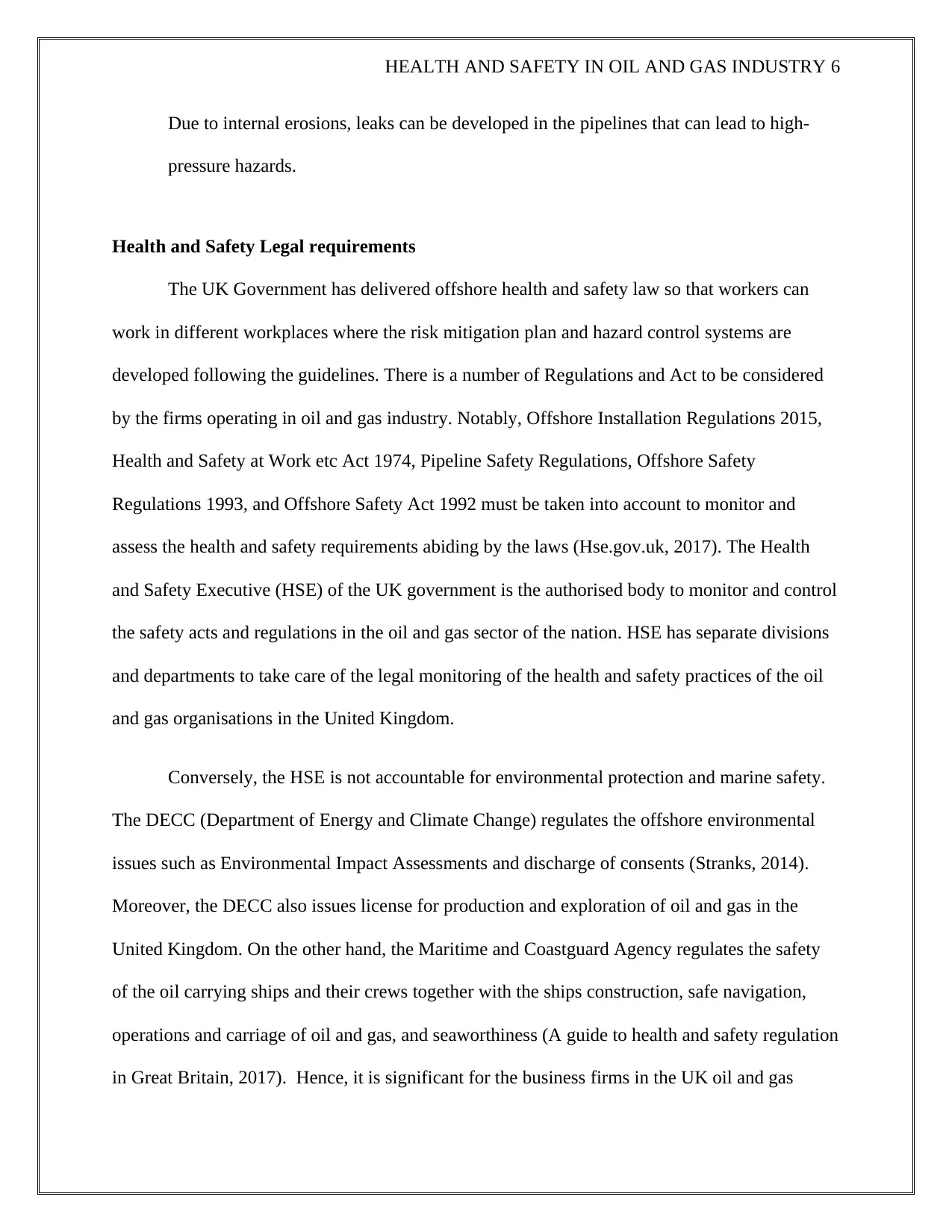
HEALTH AND SAFETY IN OIL AND GAS INDUSTRY 6
Due to internal erosions, leaks can be developed in the pipelines that can lead to high-
pressure hazards.
Health and Safety Legal requirements
The UK Government has delivered offshore health and safety law so that workers can
work in different workplaces where the risk mitigation plan and hazard control systems are
developed following the guidelines. There is a number of Regulations and Act to be considered
by the firms operating in oil and gas industry. Notably, Offshore Installation Regulations 2015,
Health and Safety at Work etc Act 1974, Pipeline Safety Regulations, Offshore Safety
Regulations 1993, and Offshore Safety Act 1992 must be taken into account to monitor and
assess the health and safety requirements abiding by the laws (Hse.gov.uk, 2017). The Health
and Safety Executive (HSE) of the UK government is the authorised body to monitor and control
the safety acts and regulations in the oil and gas sector of the nation. HSE has separate divisions
and departments to take care of the legal monitoring of the health and safety practices of the oil
and gas organisations in the United Kingdom.
Conversely, the HSE is not accountable for environmental protection and marine safety.
The DECC (Department of Energy and Climate Change) regulates the offshore environmental
issues such as Environmental Impact Assessments and discharge of consents (Stranks, 2014).
Moreover, the DECC also issues license for production and exploration of oil and gas in the
United Kingdom. On the other hand, the Maritime and Coastguard Agency regulates the safety
of the oil carrying ships and their crews together with the ships construction, safe navigation,
operations and carriage of oil and gas, and seaworthiness (A guide to health and safety regulation
in Great Britain, 2017). Hence, it is significant for the business firms in the UK oil and gas
Due to internal erosions, leaks can be developed in the pipelines that can lead to high-
pressure hazards.
Health and Safety Legal requirements
The UK Government has delivered offshore health and safety law so that workers can
work in different workplaces where the risk mitigation plan and hazard control systems are
developed following the guidelines. There is a number of Regulations and Act to be considered
by the firms operating in oil and gas industry. Notably, Offshore Installation Regulations 2015,
Health and Safety at Work etc Act 1974, Pipeline Safety Regulations, Offshore Safety
Regulations 1993, and Offshore Safety Act 1992 must be taken into account to monitor and
assess the health and safety requirements abiding by the laws (Hse.gov.uk, 2017). The Health
and Safety Executive (HSE) of the UK government is the authorised body to monitor and control
the safety acts and regulations in the oil and gas sector of the nation. HSE has separate divisions
and departments to take care of the legal monitoring of the health and safety practices of the oil
and gas organisations in the United Kingdom.
Conversely, the HSE is not accountable for environmental protection and marine safety.
The DECC (Department of Energy and Climate Change) regulates the offshore environmental
issues such as Environmental Impact Assessments and discharge of consents (Stranks, 2014).
Moreover, the DECC also issues license for production and exploration of oil and gas in the
United Kingdom. On the other hand, the Maritime and Coastguard Agency regulates the safety
of the oil carrying ships and their crews together with the ships construction, safe navigation,
operations and carriage of oil and gas, and seaworthiness (A guide to health and safety regulation
in Great Britain, 2017). Hence, it is significant for the business firms in the UK oil and gas
⊘ This is a preview!⊘
Do you want full access?
Subscribe today to unlock all pages.

Trusted by 1+ million students worldwide
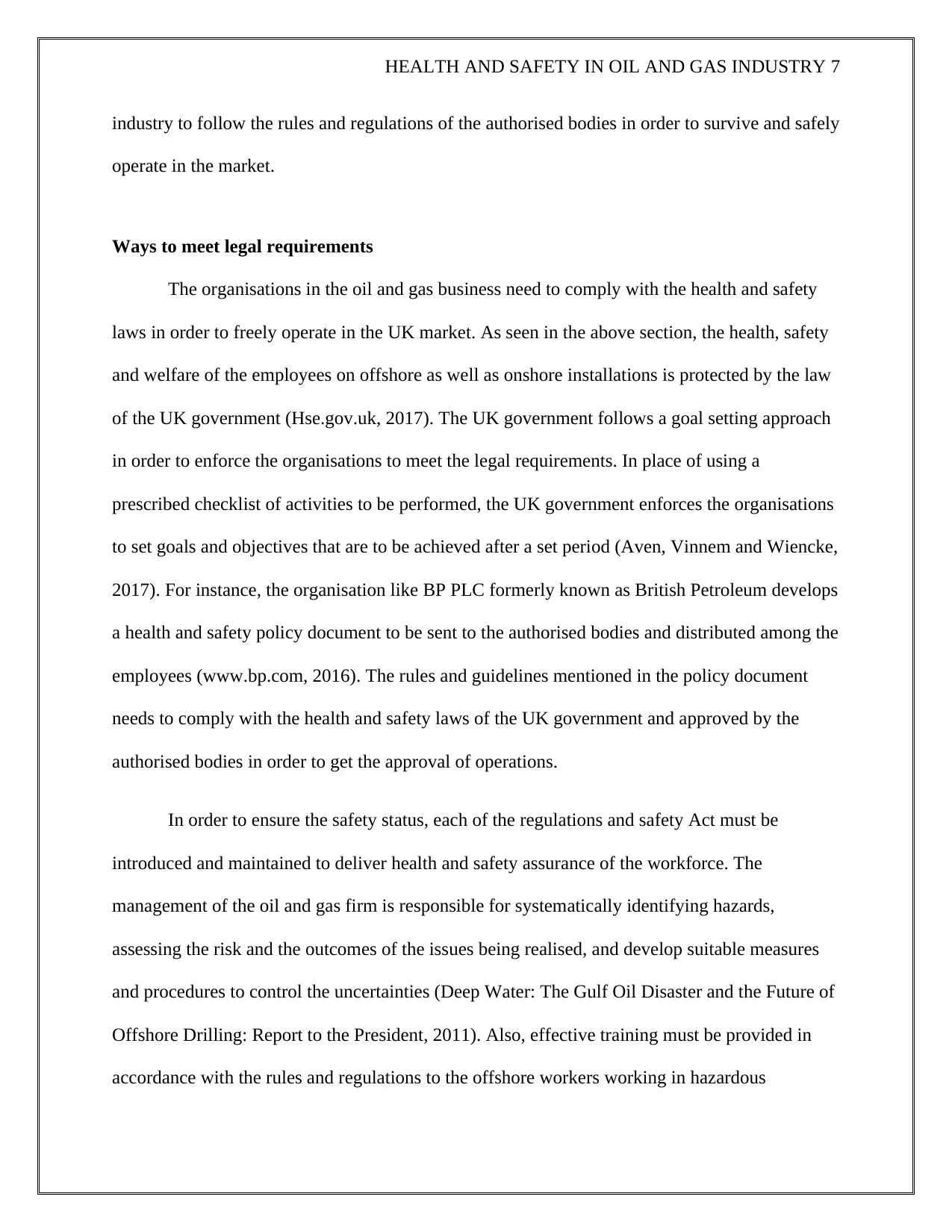
HEALTH AND SAFETY IN OIL AND GAS INDUSTRY 7
industry to follow the rules and regulations of the authorised bodies in order to survive and safely
operate in the market.
Ways to meet legal requirements
The organisations in the oil and gas business need to comply with the health and safety
laws in order to freely operate in the UK market. As seen in the above section, the health, safety
and welfare of the employees on offshore as well as onshore installations is protected by the law
of the UK government (Hse.gov.uk, 2017). The UK government follows a goal setting approach
in order to enforce the organisations to meet the legal requirements. In place of using a
prescribed checklist of activities to be performed, the UK government enforces the organisations
to set goals and objectives that are to be achieved after a set period (Aven, Vinnem and Wiencke,
2017). For instance, the organisation like BP PLC formerly known as British Petroleum develops
a health and safety policy document to be sent to the authorised bodies and distributed among the
employees (www.bp.com, 2016). The rules and guidelines mentioned in the policy document
needs to comply with the health and safety laws of the UK government and approved by the
authorised bodies in order to get the approval of operations.
In order to ensure the safety status, each of the regulations and safety Act must be
introduced and maintained to deliver health and safety assurance of the workforce. The
management of the oil and gas firm is responsible for systematically identifying hazards,
assessing the risk and the outcomes of the issues being realised, and develop suitable measures
and procedures to control the uncertainties (Deep Water: The Gulf Oil Disaster and the Future of
Offshore Drilling: Report to the President, 2011). Also, effective training must be provided in
accordance with the rules and regulations to the offshore workers working in hazardous
industry to follow the rules and regulations of the authorised bodies in order to survive and safely
operate in the market.
Ways to meet legal requirements
The organisations in the oil and gas business need to comply with the health and safety
laws in order to freely operate in the UK market. As seen in the above section, the health, safety
and welfare of the employees on offshore as well as onshore installations is protected by the law
of the UK government (Hse.gov.uk, 2017). The UK government follows a goal setting approach
in order to enforce the organisations to meet the legal requirements. In place of using a
prescribed checklist of activities to be performed, the UK government enforces the organisations
to set goals and objectives that are to be achieved after a set period (Aven, Vinnem and Wiencke,
2017). For instance, the organisation like BP PLC formerly known as British Petroleum develops
a health and safety policy document to be sent to the authorised bodies and distributed among the
employees (www.bp.com, 2016). The rules and guidelines mentioned in the policy document
needs to comply with the health and safety laws of the UK government and approved by the
authorised bodies in order to get the approval of operations.
In order to ensure the safety status, each of the regulations and safety Act must be
introduced and maintained to deliver health and safety assurance of the workforce. The
management of the oil and gas firm is responsible for systematically identifying hazards,
assessing the risk and the outcomes of the issues being realised, and develop suitable measures
and procedures to control the uncertainties (Deep Water: The Gulf Oil Disaster and the Future of
Offshore Drilling: Report to the President, 2011). Also, effective training must be provided in
accordance with the rules and regulations to the offshore workers working in hazardous
Paraphrase This Document
Need a fresh take? Get an instant paraphrase of this document with our AI Paraphraser
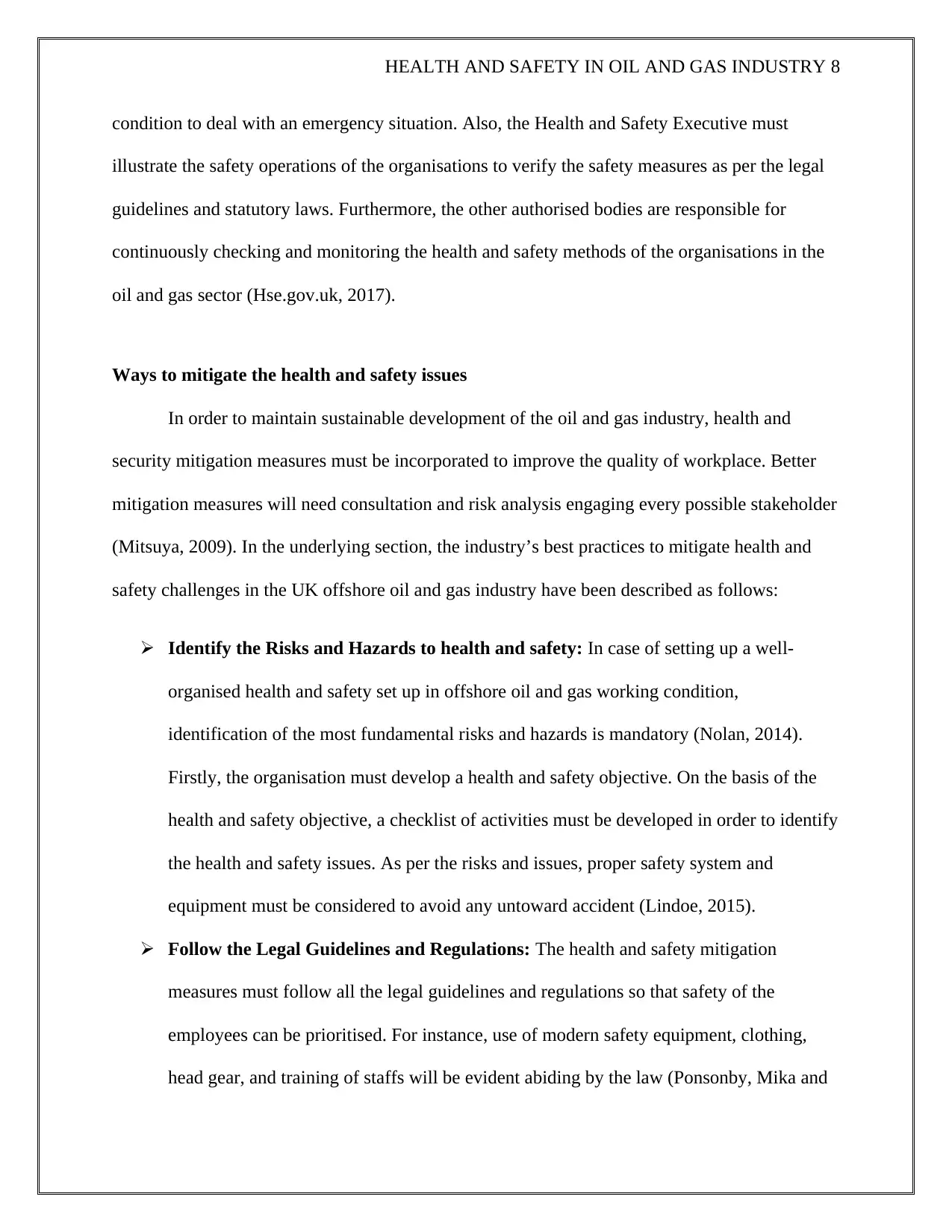
HEALTH AND SAFETY IN OIL AND GAS INDUSTRY 8
condition to deal with an emergency situation. Also, the Health and Safety Executive must
illustrate the safety operations of the organisations to verify the safety measures as per the legal
guidelines and statutory laws. Furthermore, the other authorised bodies are responsible for
continuously checking and monitoring the health and safety methods of the organisations in the
oil and gas sector (Hse.gov.uk, 2017).
Ways to mitigate the health and safety issues
In order to maintain sustainable development of the oil and gas industry, health and
security mitigation measures must be incorporated to improve the quality of workplace. Better
mitigation measures will need consultation and risk analysis engaging every possible stakeholder
(Mitsuya, 2009). In the underlying section, the industry’s best practices to mitigate health and
safety challenges in the UK offshore oil and gas industry have been described as follows:
Identify the Risks and Hazards to health and safety: In case of setting up a well-
organised health and safety set up in offshore oil and gas working condition,
identification of the most fundamental risks and hazards is mandatory (Nolan, 2014).
Firstly, the organisation must develop a health and safety objective. On the basis of the
health and safety objective, a checklist of activities must be developed in order to identify
the health and safety issues. As per the risks and issues, proper safety system and
equipment must be considered to avoid any untoward accident (Lindoe, 2015).
Follow the Legal Guidelines and Regulations: The health and safety mitigation
measures must follow all the legal guidelines and regulations so that safety of the
employees can be prioritised. For instance, use of modern safety equipment, clothing,
head gear, and training of staffs will be evident abiding by the law (Ponsonby, Mika and
condition to deal with an emergency situation. Also, the Health and Safety Executive must
illustrate the safety operations of the organisations to verify the safety measures as per the legal
guidelines and statutory laws. Furthermore, the other authorised bodies are responsible for
continuously checking and monitoring the health and safety methods of the organisations in the
oil and gas sector (Hse.gov.uk, 2017).
Ways to mitigate the health and safety issues
In order to maintain sustainable development of the oil and gas industry, health and
security mitigation measures must be incorporated to improve the quality of workplace. Better
mitigation measures will need consultation and risk analysis engaging every possible stakeholder
(Mitsuya, 2009). In the underlying section, the industry’s best practices to mitigate health and
safety challenges in the UK offshore oil and gas industry have been described as follows:
Identify the Risks and Hazards to health and safety: In case of setting up a well-
organised health and safety set up in offshore oil and gas working condition,
identification of the most fundamental risks and hazards is mandatory (Nolan, 2014).
Firstly, the organisation must develop a health and safety objective. On the basis of the
health and safety objective, a checklist of activities must be developed in order to identify
the health and safety issues. As per the risks and issues, proper safety system and
equipment must be considered to avoid any untoward accident (Lindoe, 2015).
Follow the Legal Guidelines and Regulations: The health and safety mitigation
measures must follow all the legal guidelines and regulations so that safety of the
employees can be prioritised. For instance, use of modern safety equipment, clothing,
head gear, and training of staffs will be evident abiding by the law (Ponsonby, Mika and
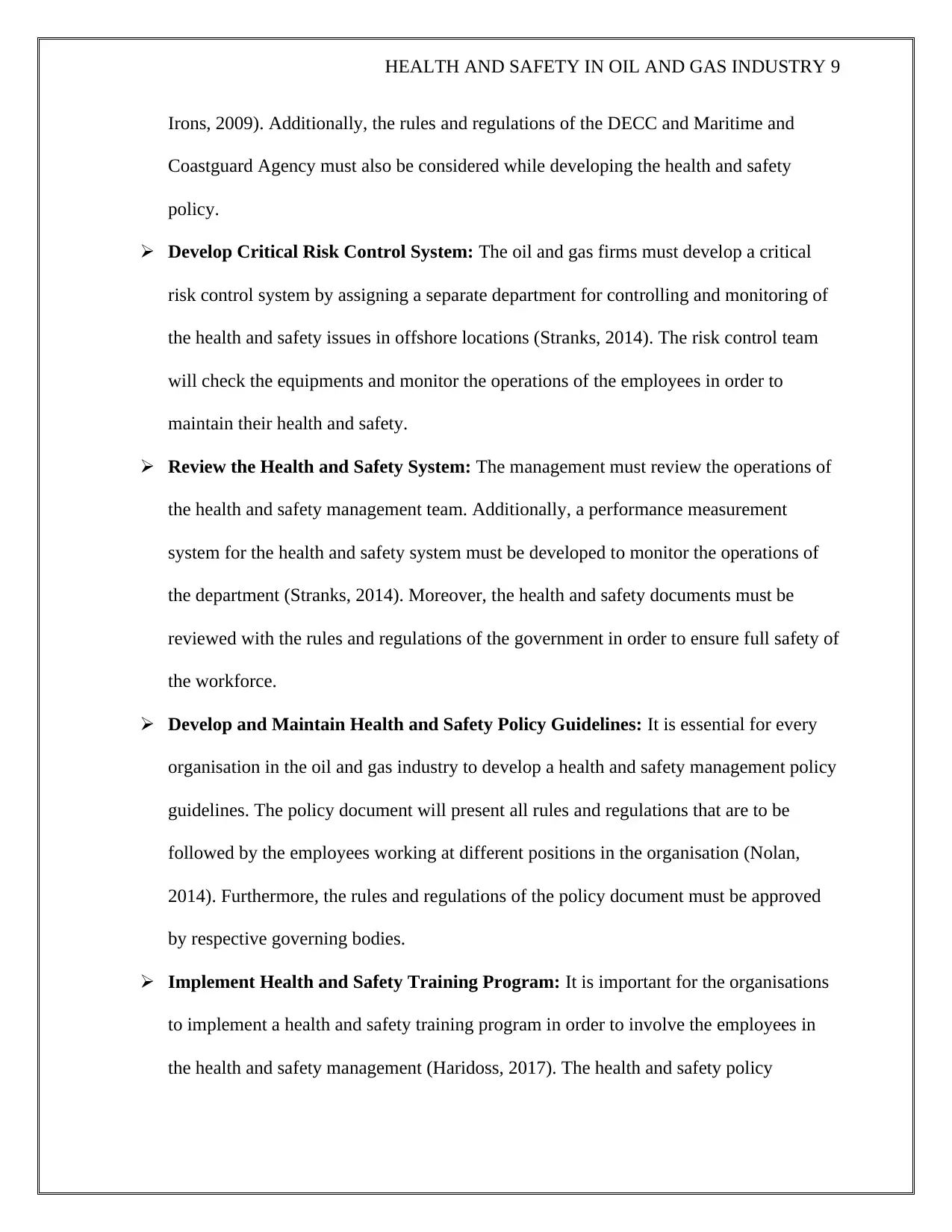
HEALTH AND SAFETY IN OIL AND GAS INDUSTRY 9
Irons, 2009). Additionally, the rules and regulations of the DECC and Maritime and
Coastguard Agency must also be considered while developing the health and safety
policy.
Develop Critical Risk Control System: The oil and gas firms must develop a critical
risk control system by assigning a separate department for controlling and monitoring of
the health and safety issues in offshore locations (Stranks, 2014). The risk control team
will check the equipments and monitor the operations of the employees in order to
maintain their health and safety.
Review the Health and Safety System: The management must review the operations of
the health and safety management team. Additionally, a performance measurement
system for the health and safety system must be developed to monitor the operations of
the department (Stranks, 2014). Moreover, the health and safety documents must be
reviewed with the rules and regulations of the government in order to ensure full safety of
the workforce.
Develop and Maintain Health and Safety Policy Guidelines: It is essential for every
organisation in the oil and gas industry to develop a health and safety management policy
guidelines. The policy document will present all rules and regulations that are to be
followed by the employees working at different positions in the organisation (Nolan,
2014). Furthermore, the rules and regulations of the policy document must be approved
by respective governing bodies.
Implement Health and Safety Training Program: It is important for the organisations
to implement a health and safety training program in order to involve the employees in
the health and safety management (Haridoss, 2017). The health and safety policy
Irons, 2009). Additionally, the rules and regulations of the DECC and Maritime and
Coastguard Agency must also be considered while developing the health and safety
policy.
Develop Critical Risk Control System: The oil and gas firms must develop a critical
risk control system by assigning a separate department for controlling and monitoring of
the health and safety issues in offshore locations (Stranks, 2014). The risk control team
will check the equipments and monitor the operations of the employees in order to
maintain their health and safety.
Review the Health and Safety System: The management must review the operations of
the health and safety management team. Additionally, a performance measurement
system for the health and safety system must be developed to monitor the operations of
the department (Stranks, 2014). Moreover, the health and safety documents must be
reviewed with the rules and regulations of the government in order to ensure full safety of
the workforce.
Develop and Maintain Health and Safety Policy Guidelines: It is essential for every
organisation in the oil and gas industry to develop a health and safety management policy
guidelines. The policy document will present all rules and regulations that are to be
followed by the employees working at different positions in the organisation (Nolan,
2014). Furthermore, the rules and regulations of the policy document must be approved
by respective governing bodies.
Implement Health and Safety Training Program: It is important for the organisations
to implement a health and safety training program in order to involve the employees in
the health and safety management (Haridoss, 2017). The health and safety policy
⊘ This is a preview!⊘
Do you want full access?
Subscribe today to unlock all pages.

Trusted by 1+ million students worldwide
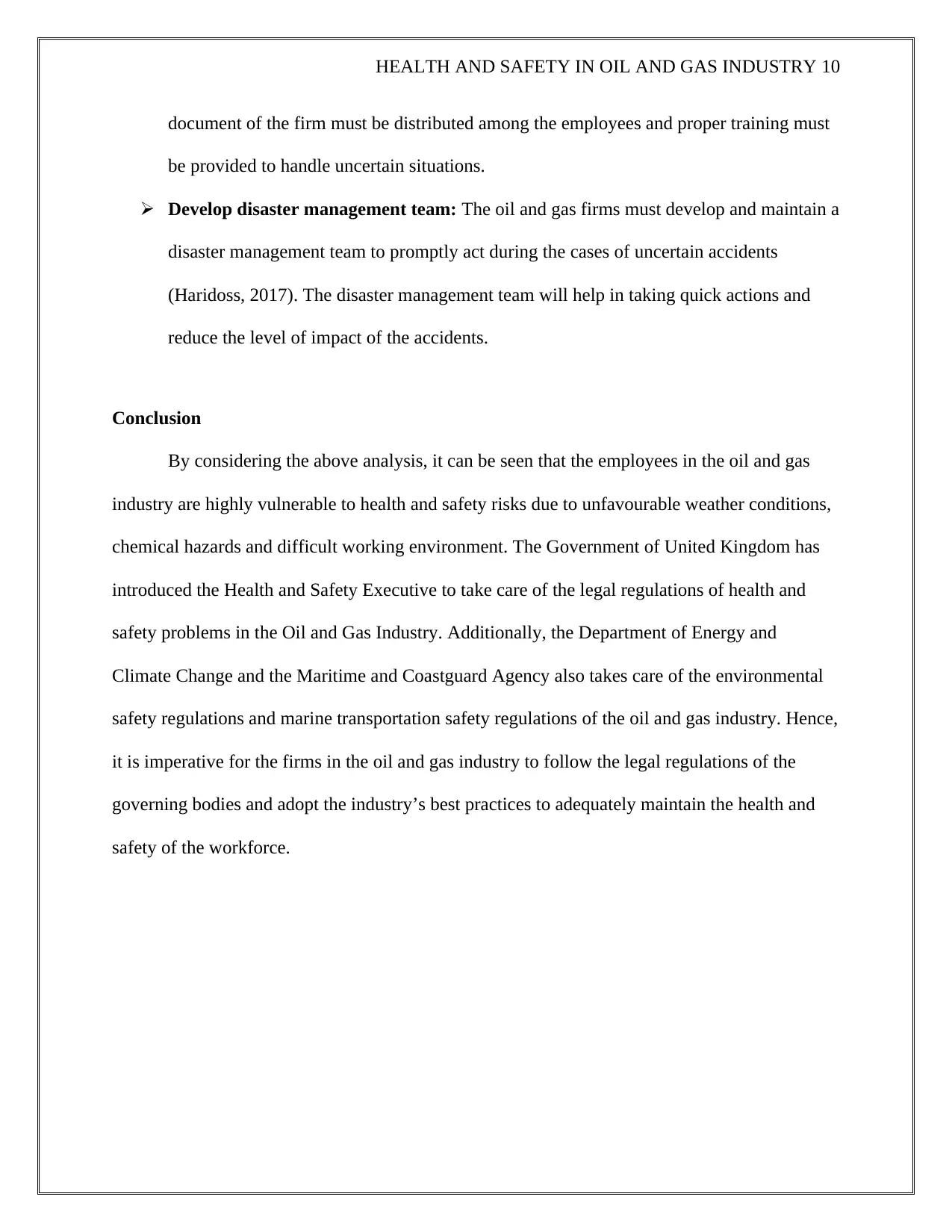
HEALTH AND SAFETY IN OIL AND GAS INDUSTRY 10
document of the firm must be distributed among the employees and proper training must
be provided to handle uncertain situations.
Develop disaster management team: The oil and gas firms must develop and maintain a
disaster management team to promptly act during the cases of uncertain accidents
(Haridoss, 2017). The disaster management team will help in taking quick actions and
reduce the level of impact of the accidents.
Conclusion
By considering the above analysis, it can be seen that the employees in the oil and gas
industry are highly vulnerable to health and safety risks due to unfavourable weather conditions,
chemical hazards and difficult working environment. The Government of United Kingdom has
introduced the Health and Safety Executive to take care of the legal regulations of health and
safety problems in the Oil and Gas Industry. Additionally, the Department of Energy and
Climate Change and the Maritime and Coastguard Agency also takes care of the environmental
safety regulations and marine transportation safety regulations of the oil and gas industry. Hence,
it is imperative for the firms in the oil and gas industry to follow the legal regulations of the
governing bodies and adopt the industry’s best practices to adequately maintain the health and
safety of the workforce.
document of the firm must be distributed among the employees and proper training must
be provided to handle uncertain situations.
Develop disaster management team: The oil and gas firms must develop and maintain a
disaster management team to promptly act during the cases of uncertain accidents
(Haridoss, 2017). The disaster management team will help in taking quick actions and
reduce the level of impact of the accidents.
Conclusion
By considering the above analysis, it can be seen that the employees in the oil and gas
industry are highly vulnerable to health and safety risks due to unfavourable weather conditions,
chemical hazards and difficult working environment. The Government of United Kingdom has
introduced the Health and Safety Executive to take care of the legal regulations of health and
safety problems in the Oil and Gas Industry. Additionally, the Department of Energy and
Climate Change and the Maritime and Coastguard Agency also takes care of the environmental
safety regulations and marine transportation safety regulations of the oil and gas industry. Hence,
it is imperative for the firms in the oil and gas industry to follow the legal regulations of the
governing bodies and adopt the industry’s best practices to adequately maintain the health and
safety of the workforce.
Paraphrase This Document
Need a fresh take? Get an instant paraphrase of this document with our AI Paraphraser
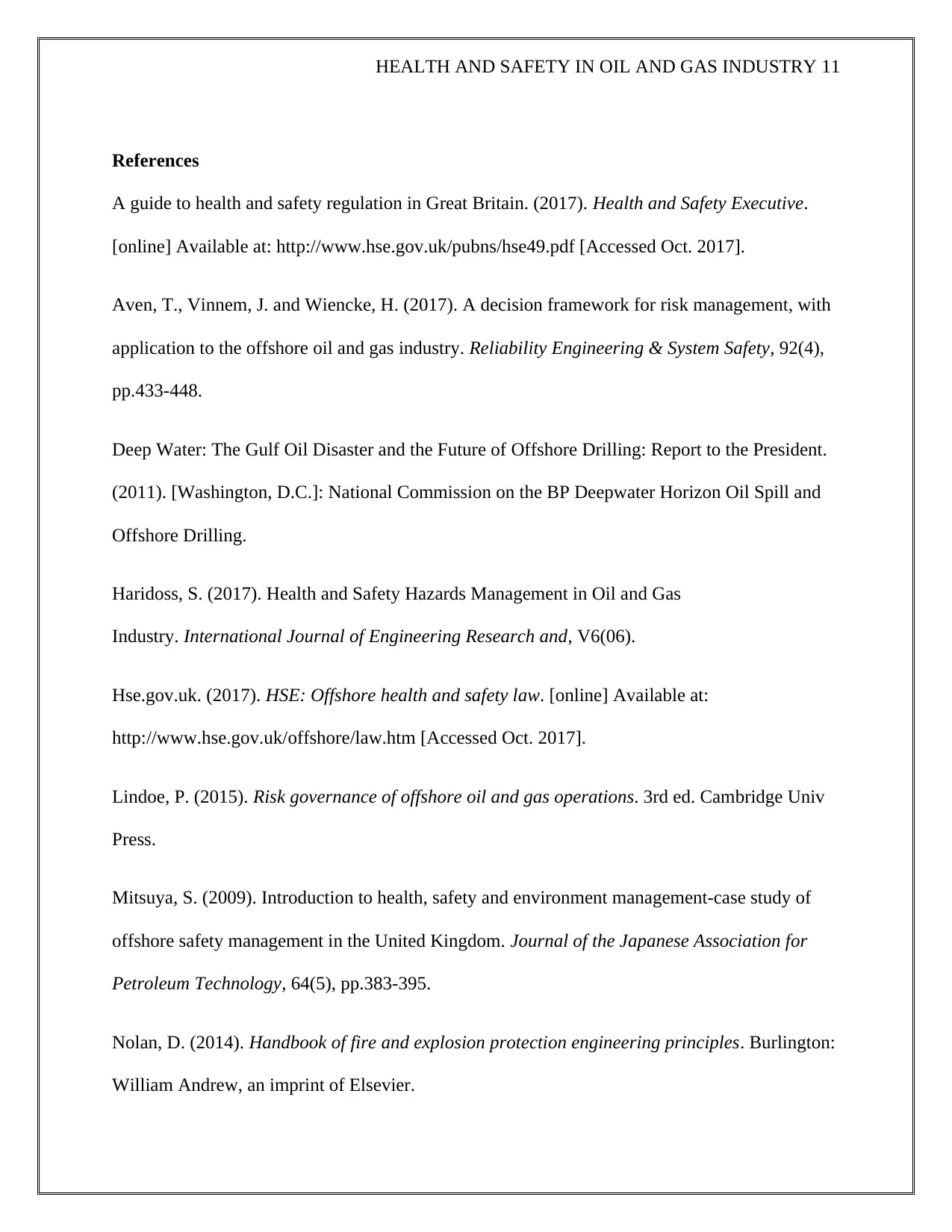
HEALTH AND SAFETY IN OIL AND GAS INDUSTRY 11
References
A guide to health and safety regulation in Great Britain. (2017). Health and Safety Executive.
[online] Available at: http://www.hse.gov.uk/pubns/hse49.pdf [Accessed Oct. 2017].
Aven, T., Vinnem, J. and Wiencke, H. (2017). A decision framework for risk management, with
application to the offshore oil and gas industry. Reliability Engineering & System Safety, 92(4),
pp.433-448.
Deep Water: The Gulf Oil Disaster and the Future of Offshore Drilling: Report to the President.
(2011). [Washington, D.C.]: National Commission on the BP Deepwater Horizon Oil Spill and
Offshore Drilling.
Haridoss, S. (2017). Health and Safety Hazards Management in Oil and Gas
Industry. International Journal of Engineering Research and, V6(06).
Hse.gov.uk. (2017). HSE: Offshore health and safety law. [online] Available at:
http://www.hse.gov.uk/offshore/law.htm [Accessed Oct. 2017].
Lindoe, P. (2015). Risk governance of offshore oil and gas operations. 3rd ed. Cambridge Univ
Press.
Mitsuya, S. (2009). Introduction to health, safety and environment management-case study of
offshore safety management in the United Kingdom. Journal of the Japanese Association for
Petroleum Technology, 64(5), pp.383-395.
Nolan, D. (2014). Handbook of fire and explosion protection engineering principles. Burlington:
William Andrew, an imprint of Elsevier.
References
A guide to health and safety regulation in Great Britain. (2017). Health and Safety Executive.
[online] Available at: http://www.hse.gov.uk/pubns/hse49.pdf [Accessed Oct. 2017].
Aven, T., Vinnem, J. and Wiencke, H. (2017). A decision framework for risk management, with
application to the offshore oil and gas industry. Reliability Engineering & System Safety, 92(4),
pp.433-448.
Deep Water: The Gulf Oil Disaster and the Future of Offshore Drilling: Report to the President.
(2011). [Washington, D.C.]: National Commission on the BP Deepwater Horizon Oil Spill and
Offshore Drilling.
Haridoss, S. (2017). Health and Safety Hazards Management in Oil and Gas
Industry. International Journal of Engineering Research and, V6(06).
Hse.gov.uk. (2017). HSE: Offshore health and safety law. [online] Available at:
http://www.hse.gov.uk/offshore/law.htm [Accessed Oct. 2017].
Lindoe, P. (2015). Risk governance of offshore oil and gas operations. 3rd ed. Cambridge Univ
Press.
Mitsuya, S. (2009). Introduction to health, safety and environment management-case study of
offshore safety management in the United Kingdom. Journal of the Japanese Association for
Petroleum Technology, 64(5), pp.383-395.
Nolan, D. (2014). Handbook of fire and explosion protection engineering principles. Burlington:
William Andrew, an imprint of Elsevier.
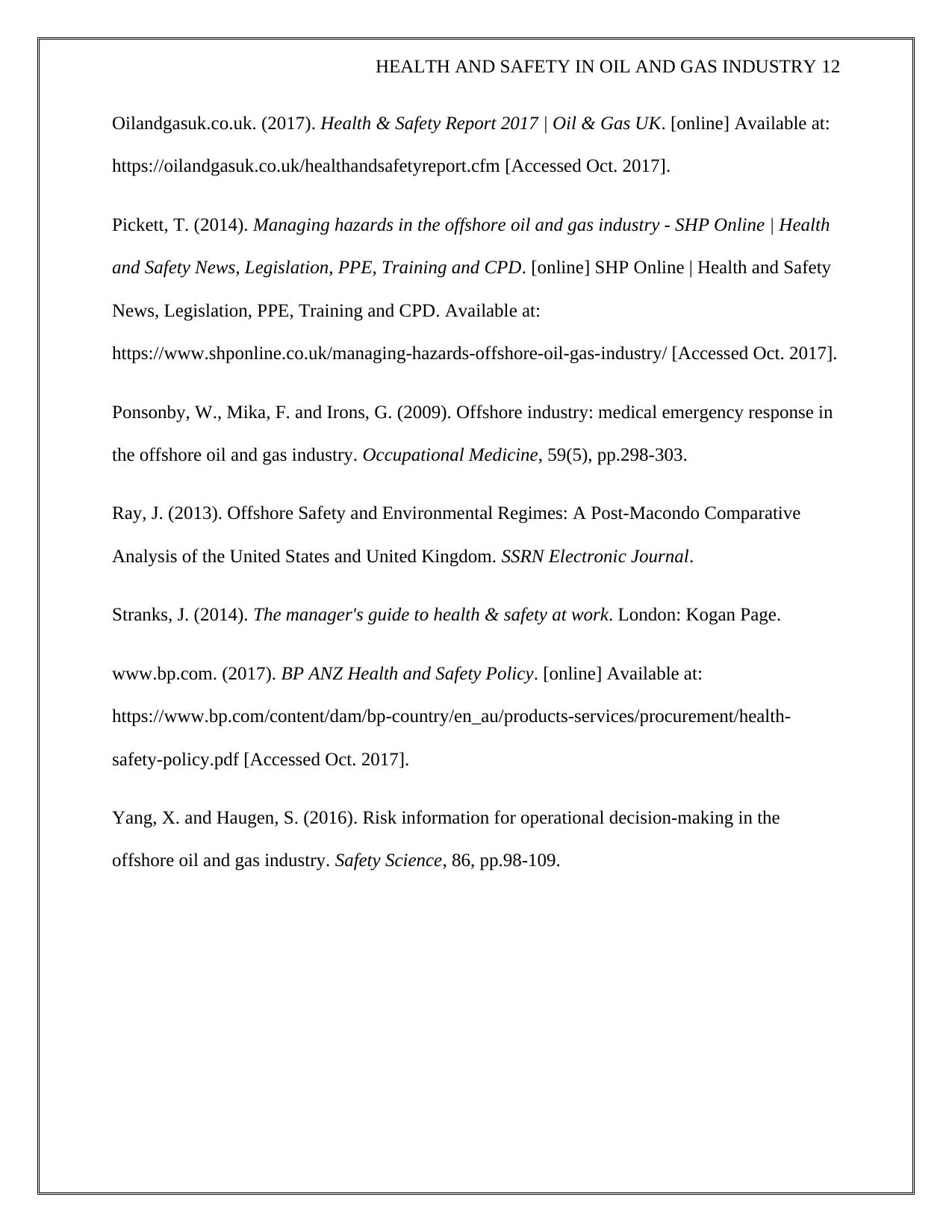
HEALTH AND SAFETY IN OIL AND GAS INDUSTRY 12
Oilandgasuk.co.uk. (2017). Health & Safety Report 2017 | Oil & Gas UK. [online] Available at:
https://oilandgasuk.co.uk/healthandsafetyreport.cfm [Accessed Oct. 2017].
Pickett, T. (2014). Managing hazards in the offshore oil and gas industry - SHP Online | Health
and Safety News, Legislation, PPE, Training and CPD. [online] SHP Online | Health and Safety
News, Legislation, PPE, Training and CPD. Available at:
https://www.shponline.co.uk/managing-hazards-offshore-oil-gas-industry/ [Accessed Oct. 2017].
Ponsonby, W., Mika, F. and Irons, G. (2009). Offshore industry: medical emergency response in
the offshore oil and gas industry. Occupational Medicine, 59(5), pp.298-303.
Ray, J. (2013). Offshore Safety and Environmental Regimes: A Post-Macondo Comparative
Analysis of the United States and United Kingdom. SSRN Electronic Journal.
Stranks, J. (2014). The manager's guide to health & safety at work. London: Kogan Page.
www.bp.com. (2017). BP ANZ Health and Safety Policy. [online] Available at:
https://www.bp.com/content/dam/bp-country/en_au/products-services/procurement/health-
safety-policy.pdf [Accessed Oct. 2017].
Yang, X. and Haugen, S. (2016). Risk information for operational decision-making in the
offshore oil and gas industry. Safety Science, 86, pp.98-109.
Oilandgasuk.co.uk. (2017). Health & Safety Report 2017 | Oil & Gas UK. [online] Available at:
https://oilandgasuk.co.uk/healthandsafetyreport.cfm [Accessed Oct. 2017].
Pickett, T. (2014). Managing hazards in the offshore oil and gas industry - SHP Online | Health
and Safety News, Legislation, PPE, Training and CPD. [online] SHP Online | Health and Safety
News, Legislation, PPE, Training and CPD. Available at:
https://www.shponline.co.uk/managing-hazards-offshore-oil-gas-industry/ [Accessed Oct. 2017].
Ponsonby, W., Mika, F. and Irons, G. (2009). Offshore industry: medical emergency response in
the offshore oil and gas industry. Occupational Medicine, 59(5), pp.298-303.
Ray, J. (2013). Offshore Safety and Environmental Regimes: A Post-Macondo Comparative
Analysis of the United States and United Kingdom. SSRN Electronic Journal.
Stranks, J. (2014). The manager's guide to health & safety at work. London: Kogan Page.
www.bp.com. (2017). BP ANZ Health and Safety Policy. [online] Available at:
https://www.bp.com/content/dam/bp-country/en_au/products-services/procurement/health-
safety-policy.pdf [Accessed Oct. 2017].
Yang, X. and Haugen, S. (2016). Risk information for operational decision-making in the
offshore oil and gas industry. Safety Science, 86, pp.98-109.
⊘ This is a preview!⊘
Do you want full access?
Subscribe today to unlock all pages.

Trusted by 1+ million students worldwide
1 out of 12
Related Documents
Your All-in-One AI-Powered Toolkit for Academic Success.
+13062052269
info@desklib.com
Available 24*7 on WhatsApp / Email
![[object Object]](/_next/static/media/star-bottom.7253800d.svg)
Unlock your academic potential
Copyright © 2020–2025 A2Z Services. All Rights Reserved. Developed and managed by ZUCOL.





